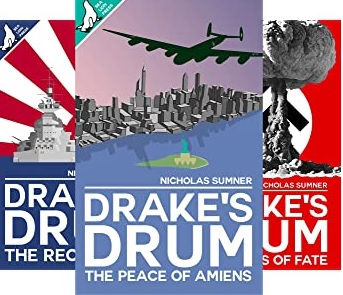Book Nook: Drake's Drum
- davidflin0
- May 17, 2023
- 4 min read
By Nicholas Sumner, Published by SLP.

This time, we’ll be reviewing the book through an interview with the author, Nicholas Sumner.
The Drake’s Drum series, published by SLP, has three volumes available, with a fourth in the production process. Each of them are among SLP’s best selling books.
I’ve interviewed the author, Nicholas Sumner. Without further ado:
What is the basic premise of Drake’s Drum? What’s it about?
Drake’s Drum is an alternate history of the world from 1915 to 2015. It focuses principally on the experience of the UK in that time. The drivers of change are different economic and industrial factors that create different outcomes. Reading that back, it sounds terribly dry, but the stories of ordinary people, both great and small, are also prominent in the narrative.
Why did you decide to do this in the style of “media snippets”?
I like the way it emulates the method someone researching a subject at the library might use. They would delve into various books or periodicals to build up an understanding from multiple sources. It also permits the writer to focus on an aspect of the story they want to highlight while still pushing the narrative forward. Gary Oswald advises me that this style is called ‘bricolage.’
You use newspaper articles, memoirs, straight description, and other source styles. How did you decide what type of media to emulate at each point? Did you find any particular style suited for any particular style of advancing a narrative point?
If I’m honest, I just tend to go with whatever media seems most suitable to get the information over and link it to the story.
What are the main themes of the series?
The technical/industrial lead that Britain gained in the Nineteenth Century was lost in the Twentieth through a combination of political and business decisions, many of which were propelled by financial circumstances. As technical/industrial leadership slipped away, so too did the country’s power, prestige, and ability to influence world events. Britain’s world leadership in industrial production caused the spread of a system of ideas that completely changed how nations and individuals could determine their affairs and acquire wealth. In the Drake’s Drum series, Britain’s relative decline in the Twentieth Century works out very differently from OTL.
Did you adopt any procedure for determining the outcome of decision points?
I wanted certain outcomes and tried to find historically plausible ways of bringing them about. In that sense, I’m not a ‘pantser’ (one whose writing process is to fly by the seat of their pants). I’m much more of a plotter.
Did you find you had to use implausible developments at certain points to get the outcome you wanted, or did things just flow naturally?
I hope none of my developments are too implausible! There’s an academic conceit that goes something like: “The more outrageous the thesis, the more citations and footnotes in the paper.” The logic of that seems (to me) to cut both ways. If you feel that people will find your alt-hist plot points a stretch, you need to justify them, to build your case with care. Academics do so with real world citations. Obviously, I’m not an academic, but I try to also build a case with OTL references. I’m sometimes criticised for having too many footnotes, but I actually cut the footnotes down for publication. I keep a copy of the manuscript with the complete footnotes on my computer in case I have to justify something later to a sceptical reader. I’m toying with the idea of putting complete footnotes on the Drake’s Drum website, but with that, there’s a danger of giving away spoilers.
Why is it called Drake’s Drum?
I can’t say directly why I named the series Drake’s Drum without giving away part of the plot of the final book. Sir Francis Drake, the English navigator and privateer, was also one of the Royal Navy’s earliest leaders. He used to beat a drum when his ship was going into action. The drum still exists and can be seen at Buckland Abbey in Devon. Legend has it that a drum beat was heard by the entire crew of HMS Revenge, a ship named for Drake’s flagship, when the Imperial German fleet surrendered at Scapa Flow in 1918. No drum or drummer was found onboard, though the ship was searched from masthead to keel. Drake is a controversial figure; the course of his life is much debated and accounts of it differ. The Victorians idolised him; in the modern age, his actions have been subject to reappraisal. Like all human beings, his character and legacy were mixed.

Replica of Drake's drum, from the Buckland Abbey education centre.
Picture courtesy Wikimedia Commons.
Drake’s Drum features a lot of big ships and big naval battles. How did you determine the course of these battles?
I’m often asked if I wargame the battles in Drake’s Drum, but the answer is that I never do. Most of the battles in the Drake’s Drum series are loosely based on an OTL engagement adapted for TTL.

HMS Nelson at the 1937 Spithead Review. Drake's Drum features lots of Big Ships.
Picture courtesy Wikimedia Commons.
There are, I believe, at various stages of production, 4 books in the series. Do you have plans for any more?
The yet to be published Drake’s Drum: The Horizon of Our Hopes, will be the fourth and last book in the series. It brings the narrative up to 2015 and the manuscript is close to being finished. I recently submitted a draft to Beta readers who have made many useful suggestions and recommended necessary changes. This has pushed the timetable back, but the finished story will be much better for their input.
***
Comment on this article HERE.
The Drake's Drum series is available HERE.




Comments